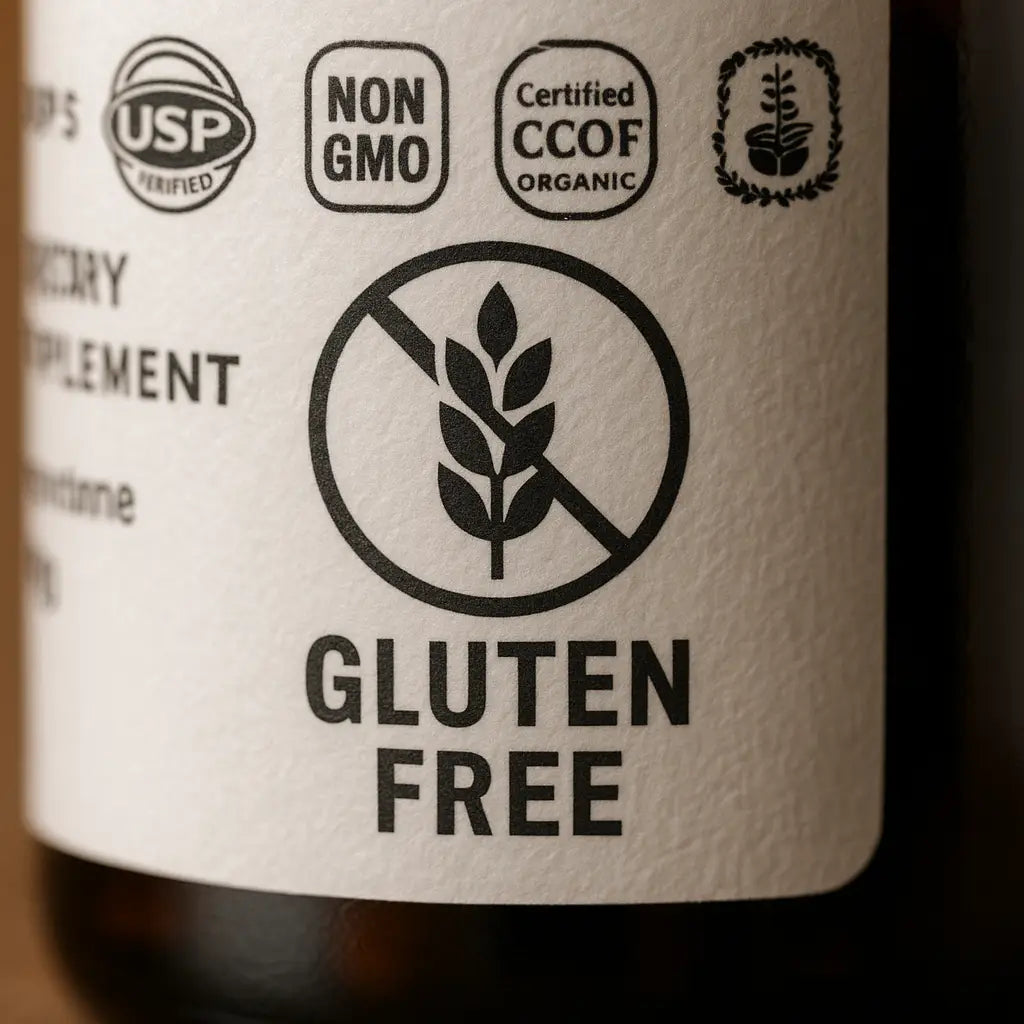
Cross Contamination: What to Check on Labels
Shopping for supplements should be simple. But when you need to avoid gluten, it can feel like navigating a minefield. Even when a product isn't made with gluten, there's always the risk of cross contamination. So how can you be sure what's safe?
Understanding what to look for on a supplement label is the key to shopping with confidence. This guide will walk you through certification marks, manufacturing notes, and common traps to help you make informed choices. We'll focus on the facts, so you can get the information you need without the fluff.
Certification: Your First Clue
When you're scanning a label, a gluten-free certification mark is a great starting point. In the UK, the most recognised symbol is the Crossed Grain trademark from Coeliac UK. This symbol is a quick way to identify products that are safe to eat. To use this mark, products must be independently verified to contain 20 parts per million (ppm) of gluten or less, which is the legal standard in the UK and EU for a "gluten-free" claim.

However, not all safe products will have this certification. The process can be expensive, especially for smaller companies. So, while the Crossed Grain symbol is a reassuring sign, its absence doesn't automatically mean a product is unsafe. It just means you need to look a little closer at the label.
Reading the Ingredients: Spotting Hidden Gluten
The ingredients list is your next port of call. By law, any of the 14 major allergens, including cereals containing gluten (like wheat, barley, and rye), must be emphasised in the ingredients list. This is usually done with bold, italic, or underlined text. This makes it much easier to spot obvious gluten-containing ingredients at a glance.

But what about less obvious sources of gluten? Some ingredients can be derived from wheat but are so highly processed that they are considered gluten-free. A common example is maltodextrin. If it's derived from wheat, the label must state this (e.g., "maltodextrin (from wheat)"). However, the processing removes the gluten protein, making it safe for most people with coeliac disease. The same applies to glucose syrups derived from wheat or barley.
Other ingredients to watch out for include:
•Modified food starch: This can sometimes be derived from wheat. If it is, the label must specify "wheat starch."
•Dextrin: Like maltodextrin, this can be made from wheat.
•"Natural flavourings" or "seasonings": These can sometimes contain gluten, so it's best to choose products where the source is specified.
Manufacturing Notes: Understanding "May Contain" Warnings
This is where things can get tricky. You've checked the ingredients, and there's no gluten in sight. But then you see a warning: "May contain traces of gluten" or "Made in a facility that also handles wheat." This is known as precautionary allergen labelling (PAL).
According to the UK's Food Standards Agency, these warnings should only be used when there's a genuine risk of cross contamination that can't be eliminated. For example, if a gluten-free product is made on the same equipment as a product containing wheat, there's a small chance that traces of gluten could carry over.
So, what should you do when you see a "may contain" warning? The safest approach is to avoid these products, especially if you are highly sensitive to gluten. While the risk may be small, it's not always possible to know how significant it is. Many people with coeliac disease choose to stick with certified gluten-free products or those with no precautionary warnings to be on the safe side.
Your Gluten-Free Shopping Strategy
Navigating the world of supplements when you have a gluten intolerance doesn't have to be a stressful experience. By following a few simple steps, you can make informed choices and find products that are right for you.
1.Look for certification. The Crossed Grain symbol is your most reliable indicator of a safe product.
2.Read the ingredients list carefully. Pay attention to emphasised allergens and be aware of potential hidden sources of gluten.
3.Take "may contain" warnings seriously. If you are highly sensitive, it's best to avoid products with these labels.
4.When in doubt, contact the manufacturer. They should be able to provide you with more information about their manufacturing processes and cross-contamination controls.
At Nutribrio, we understand the importance of providing safe and effective supplements for all our customers. That's why we have a dedicated range of gluten-free supplements to support your health and wellness goals. We are committed to clear and transparent labelling, so you can always feel confident in your choices.

Leave a comment